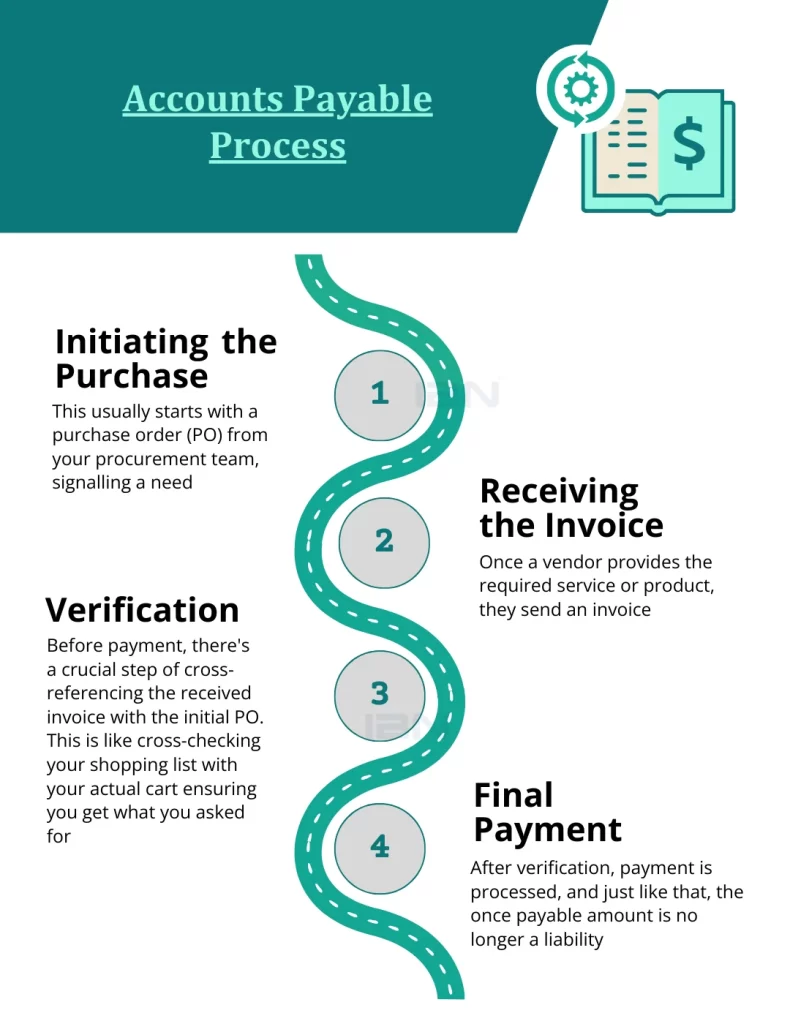
A business’s financial health is vital, whether it is large or small. Accounts payable (AP) is more than just paying bills – it’s about ensuring your business’ financial wheels turn smoothly. So, have you ever pondered about accounts payable? What makes it so essential for your business?
Table of Contents
- 1. Accounts Payable Process: What it is?
- 2. Accounts Payable Workflow Procedure
- a. Optimizing Your Accounts Payable Procedure
- b. Ensuring Precision in Accounts Payable
- c. Fostering Transparency and Accountability
- d. Challenges in accounts payable process
- e. Why Prioritize an Efficient AP Process?
- 3. Remote AP Management
- 4. Conclusion
- 5. Account payable Procedure FAQs
Accounts Payable Process: What it is?
The Accounts Payable process is a vital component within the broader accounts payable cycle, serving as a significant pillar in a business’s financial structure. It, often encapsulated in the term procure-to-pay, is an intricate step of verifying, approving, and paying for the services and products your business consumes. In essence, it’s like ensuring that your business’s heart keeps beating without any hiccups. The steps of AP processes are:

- Initiating the Purchase: This usually starts with a purchase order (PO) from your procurement team, signalling a need.
- Receiving the Invoice: Once a vendor provides the required service or product, they send an invoice.
- Verification: Before payment, there’s a crucial step of cross-referencing the received invoice with the initial PO. This is like cross-checking your shopping list with your actual cart ensuring you get what you asked for.
- Final Payment: After verification, payment is processed, and just like that, the once payable amount is no longer a liability.
This might sound simple, but with the sheer volume of transactions in a business, this becomes a sophisticated step, ensuring no step is out of place.
Accounts Payable Workflow Procedure
Optimizing Your Accounts Payable Procedure
- Invoice DigitalizationOne of the critical measures for enhancing the transparency and efficiency of your AP workflow is the digitization of invoices. By employing advanced invoice processing software, you can eliminate the use of paper and reduce the potential for human errors. This automation not only expedites invoice processing but also significantly lowers the risk of inaccuracies.
- Establishing an AP WorkflowTo attain a well-organized AP process, it is essential to establish a clearly defined workflow. This involves setting up distinct approval hierarchies, automating approval routing, and implementing standardized procedures. These steps not only expedite the process but also ensure compliance with both internal and external regulations.
See How We Streamlined AP Efficiency – Free Download the Case Study Now.
Ensuring Precision in Accounts Payable
- Data Validation
The accuracy of data serves as the bedrock of any successful AP process. Employing robust data validation techniques can help identify and rectify errors before they result in costly discrepancies. Leveraging machine learning and data analysis tools can significantly enhance the precision of your AP data.
- Three-Way Matching
A pivotal element of an efficient AP journey is the three-way matching process, which entails cross-referencing purchase orders, invoices, and receiving documents. This practice guarantees that payments are made only for what has been received, thereby reducing the likelihood of overpayment.
Fostering Transparency and Accountability
- Real-Time Reporting
To maintain transparency, it is crucial to have instantaneous access to your financial data. The implementation of robust reporting tools enables you to monitor your AP process in real-time, promptly identifying bottlenecks and areas for enhancement.
- Vendor Collaboration
Collaboration with your vendors plays a vital role in constructing a transparent AP process. Promote open communication, negotiate favorable terms, and explore opportunities for prompt payment discounts. This not only nurtures trust but also has the potential to yield cost savings.
Challenges in Accounts Payable Process
- The AP workflow is not without its challenges. Many hurdles can trip up even the most seasoned AP professionals:
- Manual Bottlenecks: Imagine trying to fill up a water bottle with a spoon—that’s what manual data entries feel like in the age of automation.
- Duplicate Entries and Lost Invoices: These can lead to overpayments or even missed payments.
- Inefficient Approval Processes: This often results in delayed payments, which can further strain vendor relationships.
- Inaccurate Records: It’s like trying to solve a puzzle with missing pieces. An inaccurate balance sheet can mislead and result in incorrect financial decisions.
That’s where AP automation steps in, acting as the wind beneath the wings of many organizations, ensuring payments are timely, discrepancies are a rarity, and efficiency is the norm.
Why Prioritize an Efficient AP Process?
- Behind every successful business is a robust and efficient accounts payable process. IBN Tech’s role in enhancing businesses through efficient accounts payable (AP) processes is essential. It ensures financial stability, aids in accurate record-keeping, fosters better vendor relations, prevents penalties, and guards against fraud. These benefits demonstrate the value IBN Tech brings to overall business success. Its significance might often be understated, but its impact is undeniable:
- Financial Stability: Efficient AP ensures consistent cash flow, vital for a business’s survival, especially in a fluctuating economy.
- Accurate Record-Keeping: Digital records mean quicker access and easier audits.
- Strengthened Vendor Relations: Prompt payments can lead to better future deals and foster trust.
- Avoidance of Penalties: Timely payments mean no more late fees. Plus, you might even snag some early payment discounts!
- Guard Against Fraud: Modern AP processes have built-in checks to flag discrepancies, acting as a sentinel against potential financial threats.
Remote AP Management
Technological advancements and the integration of cloud-based accounting software provide businesses with the capability to process invoices, execute payments, and oversee vendor relationships from virtually any location. The adoption of remote accounts payable (AP) management not only amplifies efficiency but also ensures seamless operations, proving invaluable in scenarios such as remote work arrangements and unforeseen disruptions.
Conclusion
The streamlined AP process is not just about paying bills; it’s about safeguarding the financial backbone of your company. Investing in an optimized accounts payable workflow is investing in the future of your business.
Account Payable procedure FAQs
- 1. What are the steps in accounts payable process?
- The accounts payable sequence includes issuing a purchase order, receiving an invoice, performing a detailed verification, and completing the payment to fulfill financial obligations accurately.
- 2. What are the 4 functions of accounts payable?
- The four main functions of accounts payable include invoice processing, verification and matching, payment authorization, and financial record keeping.
- 3. What is the correct accounts payable workflow?
- A proper AP workflow is marked by a systematic, error-free methodology that involves receiving invoices, ensuring their validation, securing approval, and executing timely payments.
- 4. Can you do accounts payable remotely?
- Yes, with the current cloud-based accounting systems, accounts payable tasks can be efficiently managed from remote locations, providing flexibility and ensuring the continuity of a business’s financial transactions.



